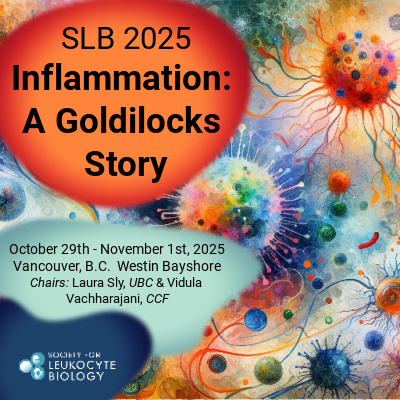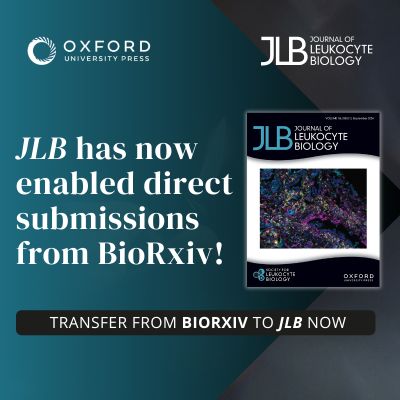| JLB Vol 111 Issue 5 TOC |
ISSUE INFORMATION Issue InformationPages: 933-937 | First Published:21 April 2022 EDITORIAL Not all the same: Subtypes of mouse intestinal eosinophils in health and disease models Mats W. Johansson
Pages: 939-941 | First Published:07 February 2022 SPOTLIGHT ON LEADING EDGE RESEARCH Modulation of surface CD11c expression tracks plasticity in murine intestinal tissue eosinophils Leigha D. Larsen, Karen Dockstader, Courtney L. Olbrich, Ian M. Cartwright, Lisa A. Spencer
Pages: 943-952 | First Published:09 February 2022 CELL DEVELOPMENT, DIFFERENTIATION, AND TRAFFICKING LncRNA SNHG8 sponges miR‐449c‐5p and regulates the SIRT1/FoxO1 pathway to affect microglia activation and blood‐brain barrier permeability in ischemic stroke Duobin Zhang, Ning Pan, Chuan Jiang, Maolin Hao
Pages: 953-966 | First Published:29 September 2021 Loss of mTORC2‐induced metabolic reprogramming in monocytes uncouples migration and maturation from production of proinflammatory mediators Maryam Jangani, Juho Vuononvirta, Lamya Yamani, Eleanor Ward, Melania Capasso, Suchita Nadkarni, Frances Balkwill, Federica Marelli-Berg
Pages: 967-980 | First Published:29 September 2021 RECEPTORS, SIGNAL TRANSDUCTION, AND GENES CTCF: A novel fusion partner of ETO2 in a multiple relapsed acute myeloid leukemia patient Jiao Li, Zhen Shen, Zheng Wang, Hongying Chao, Yi Xu, Zhao Zeng, Xiaosen Bian, Jun Zhang, Jinlan Pan, Weiwei Miao, Wenzhong Wu, Li Yao, Suning Chen, Lijun Wen
Pages: 981-987 | First Published:08 October 2021 INFLAMMATION, EXTRACELLULAR MEDIATORS, AND EFFECTOR MOLECULES Pro‐inflammatory polarization primes Macrophages to transition into a distinct M2‐like phenotype in response to IL‐4 Erin M. O'Brien, Kara L. Spiller
Pages: 989-1000 | First Published:13 October 2021 Transcription factor c‐Rel mediates communication between commensal bacteria and mucosal lymphocytes Maik Luu, Kai Binder, Sabrina Hartmann, Meike Kespohl, Jasmin Bazant, Rossana Romero, Burkhard Schütz, Ulrich Steinhoff, Alexander Visekruna
Pages: 1001-1007 | First Published:08 October 2021 HOST DEFENSE AND PATHOPHYSIOLOGY BCG‐trained innate immunity leads to fetal growth restriction by altering immune cell profile in the mouse developing placenta Yipu Dang, Camille Souchet, Fabiana Moresi, Mohamed Jeljeli, Bruno Raquillet, Carole Nicco, Sandrine Chouzenoux, Isabelle Lagoutte, Louis Marcellin, Frederic Batteux, Ludivine Doridot
Pages: 1009-1020 | First Published:17 September 2021 Flunarizine suppresses Mycobacterium tuberculosis growth via calmodulin‐dependent phagosome maturation Siwei Mo, Xiaoqian Liu, Kehong Zhang, Wenfei Wang, Yi Cai, Qi Ouyang, Chuanzhi Zhu, Dachuan Lin, Haoqiang Wan, Dechang Li, Zhihua Wen, Xinchun Chen
Pages: 1021-1029 | First Published:17 September 2021 Differential expression of maturation and activation markers on NK cells in patients with active and latent tuberculosis Nurhan Albayrak, Violette Dirix, Laetitia Aerts, Anne Van Praet, Audrey Godefroid, Nicolas Dauby, Patricia Windey, Inge Muylle, Françoise Mascart, Véronique Corbière
Pages: 1031-1042 | First Published:10 December 2021 SYSTEM BIOLOGY AND IMMUNOGENETICS Stem cells from exfoliated deciduous teeth transplantation ameliorates Sjögren's syndrome by secreting soluble PD‐L1 Ning Yang, Xuemei Liu, Xu Chen, Si Yu, Wenxiao Yang, Yao Liu
Pages: 1043-1055 | First Published:08 October 2021  Graphical Abstract Stem cells from human exfoliated deciduous teeth (SHED)-mediated rescue of Treg/Th17 balance via the sPD-L1/PD-1 pathway ameliorates the gland inflammation and dryness symptoms in SS mice, suggesting that SHED are a promising source for treating autoimmune diseases in a clinical setting. REVIEWS A curious case of cyclin‐dependent kinases in neutrophils Ramizah Syahirah, Alan Y. Hsu, Qing Deng
Pages: 1057-1068 | First Published:21 February 2022 Circulating inflammatory cell profiling and periodontitis: A systematic review and meta‐analysis Rizky A. Irwandi, Sandra O. Kuswandani, Simon Harden, Debora Marletta, Francesco D'Aiuto
Pages: 1069-1096 | First Published:24 February 2022 The role of naturally acquired antimalarial antibodies in subclinical Plasmodium spp. infection Katherine O'Flaherty, Merryn Roe, Freya J.I. Fowkes
Pages: 1097-1105 | First Published:20 January 2022 COVID-19 INITIAITVE VIP plasma levels associate with survival in severe COVID‐19 patients, correlating with protective effects in SARS‐CoV‐2‐infected cells Jairo R. Temerozo, Carolina Q. Sacramento, Natalia Fintelman-Rodrigues, Camila R. R. Pão, Caroline S. de Freitas, Suelen Silva Gomes Dias, André C. Ferreira, Mayara Mattos, Vinicius Cardoso Soares, Lívia Teixeira, Isaclaudia G. Azevedo-Quintanilha, Eugenio D. Hottz, Pedro Kurtz, Fernando A. Bozza, Patrícia T. Bozza, Thiago Moreno L. Souza, Dumith Chequer Bou-Habib
Pages: 1107-1121 | First Published:24 March 2022  Graphical Abstract In severe COVID-19 patients, VIP plasma levels correlated with decreased inflammatory markers and survival. In in vitro assays with monocytes and lung epithelial cells, VIP and PACAP were found to decrease SARS-CoV-2 RNA synthesis (monocytes) and viral replication (lung epithelial cells). Both neuropeptides also reduced inflammatory factors and cell death of infected cells. ERRATUM ErratumPages: 1123 | First Published:21 April 2022
|















 This article is a correction.
This article is a correction.

